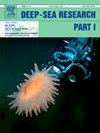Short-period cross-strait internal waves from wave-topography-hydrodynamics interactions: Observations and 3-D model results in the strait of Gibraltar
IF 2.3
3区 地球科学
Q2 OCEANOGRAPHY
Deep-Sea Research Part I-Oceanographic Research Papers
Pub Date : 2025-01-15
DOI:10.1016/j.dsr.2025.104443
引用次数: 0
Abstract
The origin, characteristics, and behavior of cross-strait short-period internal waves in the Strait of Gibraltar are analyzed, by means of a 3D, baroclinic, non-hydrostatic, hydrodynamic model, as well as satellite SAR images. The origin of these cross-strait waves was found to be related to the reflection of the main longitudinal (along-strait) internal wave on the continental shelf slope, where the reflected wave is firstly arrested by the eastward tidal current, and then released towards the northern coast once this tidal current has weakened enough to achieve its subcritical value. The main example of this topographic wave interaction is the cross-strait internal wave reflected from the African shore east of Tangier Bay, which propagates north-westwards towards the Iberian coast near Tarifa. Other waves along the Strait are also found. The latter explains the presence of internal waves in unexpected directions of propagation at times far later than the main longitudinal wave at certain locations, all of them with plausible influence on mixing processes, upwelling phenomena and biogeochemical activity in the area.
海峡两岸波浪-地形-水动力相互作用的短周期内波:直布罗陀海峡的观测和三维模式结果
利用三维斜压、非静、水动力模型和卫星SAR图像,分析了直布罗陀海峡两岸短周期内波的来源、特征和行为。这些海峡两岸波的成因与主要的纵向(海峡沿岸)内波在大陆架斜坡上的反射有关,反射波首先被向东的潮流阻挡,当这股潮流减弱到亚临界值时,反射波就向北海岸释放。这种地形波相互作用的主要例子是从丹吉尔湾以东的非洲海岸反射的海峡两岸内波,它向西北方向传播到塔里法附近的伊比利亚海岸。沿着海峡还发现了其他波浪。后者解释了在某些地点,内波在意想不到的传播方向上的存在,有时远远晚于主纵波,所有这些都对该地区的混合过程、上升流现象和生物地球化学活动产生了合理的影响。
本文章由计算机程序翻译,如有差异,请以英文原文为准。
求助全文
约1分钟内获得全文
求助全文
来源期刊
CiteScore
4.60
自引率
4.20%
发文量
144
审稿时长
18.3 weeks
期刊介绍:
Deep-Sea Research Part I: Oceanographic Research Papers is devoted to the publication of the results of original scientific research, including theoretical work of evident oceanographic applicability; and the solution of instrumental or methodological problems with evidence of successful use. The journal is distinguished by its interdisciplinary nature and its breadth, covering the geological, physical, chemical and biological aspects of the ocean and its boundaries with the sea floor and the atmosphere. In addition to regular "Research Papers" and "Instruments and Methods" papers, briefer communications may be published as "Notes". Supplemental matter, such as extensive data tables or graphs and multimedia content, may be published as electronic appendices.

 求助内容:
求助内容: 应助结果提醒方式:
应助结果提醒方式:


